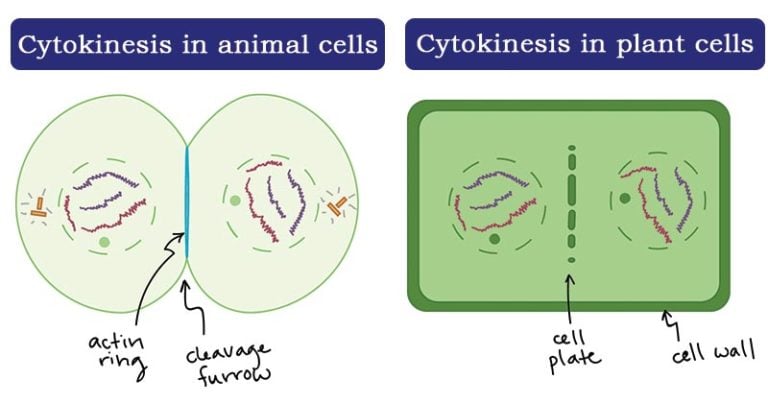difference between cytokinesis in plant and animal cells Cytokinesis cells mitosis cycle division interphase anaphase majors actin metaphase filaments
The incredible complexity and beauty of life can sometimes be mind-boggling. Take for example, the process of cell reproduction, known as the cell cycle. With each cycle, cells go through a series of meticulously orchestrated steps, resulting in the creation of new cells. One crucial step in this process is cytokinesis, the physical separation of the cell into two daughter cells. Let’s dive into this fascinating process and explore the intricacies it entails. Cytokinesis occurs after the cell has gone through the stages of mitosis, where the genetic material is divided equally between the two daughter cells. It’s like a carefully choreographed dance, ensuring that each new cell receives the necessary genetic material to carry out its functions. While different organisms may undergo cytokinesis in slightly different ways, the underlying principle remains the same – the cell must divide, and each daughter cell needs to have a complete set of genetic information. To understand cytokinesis, it helps to visualize the process. In the accompanying images, we can observe a cell in the process of dividing. The first image shows the cell at the beginning of cytokinesis, with a distinct constriction in the middle. This is known as the cleavage furrow. It’s like a tiny crevice that progressively deepens until it eventually separates the cell into two distinct entities. As the furrow forms, it becomes narrower and tighter, acting as a physical boundary between the two emerging daughter cells. The second image provides a closer look at the final stages of cytokinesis. Here, we can see the cleavage furrow has almost completely divided the cell into two. The genetic material has been successfully distributed, and the daughter cells are ready to embark on their respective journeys. It’s fascinating to witness how such a seemingly simple crevice can have such profound consequences. Now that we have a visual understanding of cytokinesis, let’s delve deeper into the cellular mechanisms behind this wondrous process. During cytokinesis, a contractile ring composed of actin and myosin proteins forms around the equator of the dividing cell. This contractile ring constricts, much like a tightening belt, creating the cleavage furrow we observed in the images. The actin and myosin proteins work together in a coordinated effort, similar to tiny muscles, to pull the cell membrane inward, resulting in the division of the cell. The role of the contractile ring isn’t just limited to physically dividing the cell. It also plays a crucial role in ensuring that each new daughter cell receives an equal and complete distribution of the cell’s organelles and cytoplasmic components. This process, known as cytokinesis in animal cells, is essential for the proper functioning of our bodies. Without it, our cells wouldn’t be able to replenish, grow, or repair damaged tissues. Cytokinesis in plant cells differs slightly from that in animal cells. Instead of a contractile ring, plant cells build a new cell wall at the site of cell division. This new cell wall formation is guided by the specialized Golgi vesicles containing cell wall components. These vesicles fuse together, forming a new cell plate that eventually expands and fuses with the existing cell wall. The result is the formation of two distinct daughter cells, complete with their own cell walls. In conclusion, cytokinesis is a remarkable process that demonstrates the intricacy and precision of life. From the formation of the cleavage furrow to the contractile ring’s action in dividing the cell, every step is crucial in ensuring the equal distribution of genetic material and the creation of new, fully functional cells. Whether in animal or plant cells, cytokinesis plays an essential role in the regeneration and growth of living organisms. Embarking on this cellular journey, we witness the miracles of life unfolding before our very eyes. (Image 1: Biology 2e, The Cell, Cell Reproduction, The Cell Cycle | OpenEd CUNY) (Image 2: Cytokinesis | Biology for Majors I)
If you are searching about Cytokinesis | Biology for Majors I you’ve came to the right place. We have 5 Pics about Cytokinesis | Biology for Majors I like Cytokinesis in animal cell versus plant cell. | Plant cell, Animal cell, Difference Between Plant and Animal Cytokinesis | Compare the and also Biology 2e, The Cell, Cell Reproduction, The Cell Cycle | OpenEd CUNY. Read more:
Cytokinesis | Biology For Majors I
 courses.lumenlearning.comcytokinesis cells mitosis cycle division interphase anaphase majors actin metaphase filaments
courses.lumenlearning.comcytokinesis cells mitosis cycle division interphase anaphase majors actin metaphase filaments
Cytokinesis- Definition And Process (in Animal And Plant Cells)
 microbenotes.comcytokinesis
microbenotes.comcytokinesis
Biology 2e, The Cell, Cell Reproduction, The Cell Cycle | OpenEd CUNY
 opened.cuny.educell cycle mitosis biology cytokinesis animal plate phase which metaphase diagram forms plant cells furrow vesicles cleavage membrane forming ring
opened.cuny.educell cycle mitosis biology cytokinesis animal plate phase which metaphase diagram forms plant cells furrow vesicles cleavage membrane forming ring
Difference Between Plant And Animal Cytokinesis | Compare The
 www.differencebetween.comcytokinesis similar
www.differencebetween.comcytokinesis similar
Cytokinesis In Animal Cell Versus Plant Cell. | Plant Cell, Animal Cell
 www.pinterest.complant animal cell cytokinesis versus issh
www.pinterest.complant animal cell cytokinesis versus issh
Cytokinesis cells mitosis cycle division interphase anaphase majors actin metaphase filaments. Cytokinesis similar. Cytokinesis- definition and process (in animal and plant cells)